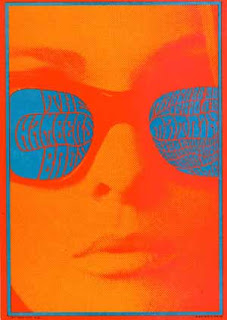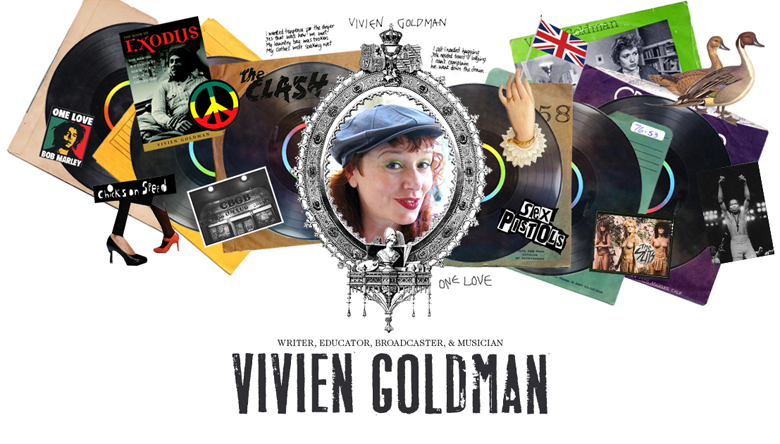Aha! A special welcome to you in the back there. After the last class, the Psychedelic Roger Waters/Pink Floyd session, when everyone else had gone and you just sat there watching mental television on the blank wall, I wasn’t sure you’d make it back intact. What was that? On your trip you lived through the last hundred years of your family tree? Well, in that case, you’ve got a head start on today’s class as we’re still looking at the 1960s; a decade whose influence remained strong in the 1970s, even though lots of Punks said it was all a load of bollocks. We will see that the Hippies’ ideas of Peace and Love were actually not that different from the Punks' Search and Destroy; because both generations were fighting in their own way for a more honest society.
“Summer of Love, Remembering the 1960s”, a show at the Whitney, is a reminder of why that decade still fascinates. Musical entertainment at the opening soiree, which I attended with Punky PR Mummy, Oberon Sinclair-Carin, was provided by hippy bard, Donovan, who swung his way through favourites like Mellow Yellow. His hair still in artless ringlets, the genial Donovan confided to us that he always watches BBC America when he’s in the US, and that his stepson with wife Linda, whose father was the late Rolling Stone Brian Jones, is obsessed with old school reggae.

“Summer of Love, Remembering the 1960s”, a show at the Whitney, is a reminder of why that decade still fascinates. Musical entertainment at the opening soiree, which I attended with Punky PR Mummy, Oberon Sinclair-Carin, was provided by hippy bard, Donovan, who swung his way through favourites like Mellow Yellow. His hair still in artless ringlets, the genial Donovan confided to us that he always watches BBC America when he’s in the US, and that his stepson with wife Linda, whose father was the late Rolling Stone Brian Jones, is obsessed with old school reggae.

Gene Anthony – Hippies on the Corner of the Haight. Image courtesy of the Whitney Museum of American Art

Mati Klarwein Aleph Sanctuary View. Image courtesy of the Whitney Museum of American Art
The exhibition’s focus on entertainment, music and underground art like British comic book, Oz, make it a magnet for music people. Among the swinging gear on display: Richard Avedon’s famous oversaturated color images of the Beatles, looking as if they were Indian deities; Patrick Litchfield’s shot of the newly married Mick & Bianca Jagger in a Rolls, she the height of Biba and Ossie Clarke chic in her white floppy hat, both imperious in their beauty, like they were off to honeymoon in Olympus. I adored this expo. For me it LITERALLY hit home, particularly as it showed London murals that I vaguely recalled from my early childhood, like the wall of Granny Takes a Trip on the King’s Road, very near where Vivienne Westwood and Malcolm McLaren would open the shop Sex, the home of punk, a decade on. A stellar Sixties crew of artists includes paintings, photos, sculptures and installations by Richard Hamilton, Mati Klarwein (of Santana sleeve fame,) Jimi Hendrix, Lynda Benglis and Andy Warhol, among others, and the show was organized by Christoph Grunenberg, director of the exhibition's originating museum, the Tate Liverpool.

Gene Anthony photo of beat generation icon Ken Kesey. Image courtesy of the Whitney Museum of American Art

Victor Moscoso Neon Rose 12. Image courtesy of the Whitney Museum of American Art
It was a joy to experience once more the elaborate rococo Edwardiana, the lush decadence of the illustrations inspired by Aubrey Beardsley and the organic voluptuousness of Art Nouveau; all those pre-Deco decorative flourishes which came to seem redundant when minimalism and its spawn, the color taupe, took their wraithlike hold on the design world. Though it skipped a couple of generations, it struck me as I tripped (hoho) past the warning for epileptics and those of a sensitive disposition and entered the exhibition’s strobe room, how it felt like an Ibiza house rave, from the 1980s through to today. That psychedelia never really went away. But it’s often said that the political awakening and awareness that the 1960s have come to represent got lost somewhere round the 1980s Greed Is Good era and never quite returned. Still, hiphop, whose birth paralleled punk’s in the 1970s, has always had a strain of conscious activism duking it out with the taboo vocabulary and mutely gyrating “video ho’s”. Hiphop guru, Russell Simmons has had to busy himself with more than one culture battle recently. The Don Imus debacle has seen Simmons align himself with a purging of hiphop’s crasser gangsta aspect; and the brazen inequities of the Rockefeller Drug Laws have prompted him to tackle the government directly, as Lockdown, a new documentary directed by Michael Skolnik and Rebecca Chaikin, explains. “We thought it would be a quick shoot, eight weeks and they’d close the deal to change the law. It wound up taking three years to just to finish the documentary, and the fight isn’t over yet,” Skolnik says.

Hiphop guru Russell Simmons
The draconian, antiquated and brutally punitive Rockefeller Drug Laws first brought in to combat the ravages of angel dust or heroin in the 1970s, have long been ineffective for dealing with any problems created by drugs, and are really a tool to tear families apart, ruin lives, and criminalize mainly Black and Latino prisoners; effectively castrating their citizenship by ensuring they’ll never get to vote. A pernicious social bargain views prisoners as a cheap, convenient work force, whose housing has become a growth industry re-energizing dying industrial towns; while keeping a prisoner in jail costs us taxpayers 60K a year. To that staggering sum must be added the social costs, which are literally incalculable. The fact that African-American women are in the front line of HIV infection is just one of the side effects, as previously straight prisoners adapt to their incarceration, and infect their women on release. While many mothers who find themselves effectively single mothers are heroines, few would dispute that having a male in the home is usually a plus. No conversation on the Rockefeller Drug Laws passes without someone observing that your Wall Street cocaine user never gets hit with the legislation that sends a small fry street corner hustler away for years. The answer to that math can be found in serious issues like the rise in gang violence plaguing our cities.
As “Lockdown USA” points out, New York’s Governor Elliot Spitzer’s election campaign promised to deal with the Laws, but somehow it all got sidelined once he was elected. Some slight cosmetic improvement did happen in 2004, when the sentence was cut from fifteen years to life, to eight to twenty-one years – but that’s still like a lifetime to a young person caught with as little as two ounces of any narcotic.
Skolnik and Chaikin focus their lens on the case of Darryl Best, who wound up in jail after signing for a package that arrived while he was working at a friend’s house, which turned out to contain drugs. The traumatic effect of his imprisonment on his family is interwoven with Simmons’ own struggle with “politricks,” as reggae singer, Peter Tosh used to say.
When the music mogul realizes that Governor Spitzer hadn’t acted on the deal Simmons thought he’d successfully brokered, he is visibly shocked and tells a reporter, “No matter how much these politicians are wiggling, they are guilty, going for their summer vacation leaving people suffering in jail who they know should come home. Politicians call themselves civilized, but in hiphop we have to tell the truth to each other. People come from the struggle and are sometimes not so polished, and you can’t go around lying, splitting the truth. In the rap business people get killed over shit like this. If I lied to my artists, I’d be dead!”
Comments Gabriel Sayegh of the Drug Policy Alliance, “New York has been waiting for reform for thirty-four years and nothing’s going to move until Governor Spitzer lives up to his campaign promise and makes it a priority.”
In short, you in the back there, if you insist on INDULGING YOUR TASTE FOR PSYCHEDELICS – make sure you do it when there are no surveillance cameras AROUND.
Lockdown USA will be released later this year.
Whitney exhibition ends September 16.
